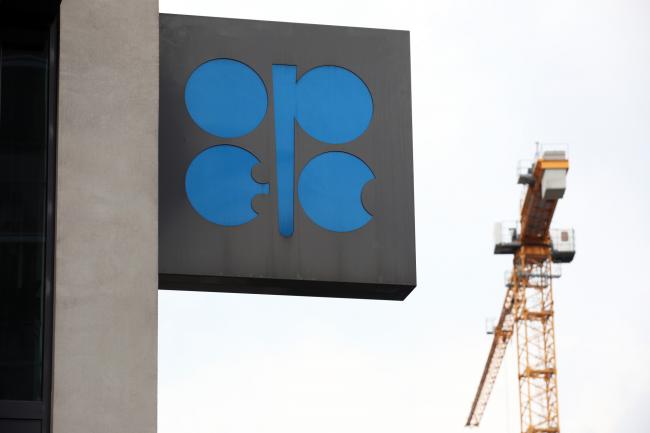(Bloomberg) -- Fifteen days from now, nations that pump more than half the world’s oil gather in Vienna to discuss extending the production cuts that helped lift prices to two-year highs. The outcome is far from certain.
Russia, which alongside Saudi Arabia was the architect of the historic cooperation between crude producers, is said to be unconvinced that a decision is needed so soon because the deal expires at the end of March. While OPEC Secretary-General Mohammad Barkindo sees no opposition in principle to continuing the supply curbs, the extension could be as short as three months or as long as nine.
There’s good reason for doubts to creep into the deliberations. While forecasters agree that the production cuts have depleted bloated fuel stockpiles in recent months, there’s huge divergence in forecasts for 2018. Brent crude is finally trading above $60 a barrel, but it’s unclear whether that’s down to an improving market or the huge increase in speculative bets.
OPEC and Russia’s deal doesn’t expire for four months, but procrastinating in a volatile market with high expectations carries some risks.
“Any postponement in deciding a supply-cut extension, or even a disappointment relative to the duration of an extension, can easily lead to unraveling of speculative length on futures and a price correction,” said Harry Tchilinguirian, head of commodity-markets strategy at BNP Paribas (PA:BNPP) SA.
Preparations for the Nov. 30 meeting in the Austrian capital begin one week earlier, with a workshop to discuss the outlook for shale oil followed by the meeting of the Organization of Petroleum Exporting Countries’ Economic Commission Board, said one delegate. This panel of representatives from member countries, which discusses the market before every ministerial meeting, will focus on forecasts for demand this winter, including consideration of the International Energy Agency’s estimate for weaker-than-expected fuel consumption, another delegate said.
Moscow Meeting
Speculation has grown that the cuts would continue beyond expiry, potentially to the end of 2018, after Russian President Vladimir Putin signaled that he’s open to such a move. Yet, he also said there had been no decision in Moscow.
Russian Energy Minister Alexander Novak, who met with bosses of the nation’s major oil companies in Moscow on Wednesday, has previously said that there won’t necessarily be a decision this month whether to extend the cuts. It’s hard to see if such a move is needed so long before the deal’s expiry, he said on Nov. 2. Moscow also dragged its feet at the OPEC meeting a year ago, keeping the market guessing until the last moment about whether it would join the cuts.
Cooperation with OPEC is “fruitful,” Tatneft PJSC Chief Executive Officer Nail Maganov told reporters after the meeting with Novak. Market monitoring and discussions need to continue, said Gazprom (MCX:GAZP) Neft PJSC CEO Alexander Dyukov.
Russia and its companies are “fully committed to the current parameters of the agreement,” the Energy Ministry said on its website. The executives at the meeting have differing opinions about whether an extension is necessary or how long it could last, and the talks with Novak didn’t yet reach a consensus, said a government official familiar with the matter, asking not to be named because they’re not authorized to speak to the press. Discussions will resume next week.
The leaders of Russia’s largest producers, who didn’t attend the meeting in Moscow, have previously voiced concerns about extending the deal. Lukoil PJSC’s billionaire CEO Vagit Alekperov said last month that the deal should end if oil prices reach $60 a barrel. Rosneft PJSC boss Igor Sechin has warned that growing U.S. shale output is undermining their efforts.
Diverging Forecasts
OPEC’s own forecasts could give members reason to think a full extension to the end of 2018 is unnecessary. With predictions for strong demand and a more modest expansion in production from non-members, inventories would decline at a rapid pace of 670,000 barrels a day through the year if the group and its allies keep supplies constrained.
“The latest OPEC figures could be interpreted as weakening the case for such a deal to already be agreed at the upcoming meeting,” Vienna-based consultant JBC Energy GmbH said in a report.
Yet the IEA sees demand for OPEC’s crude next year at 32.4 million barrels a day, 1 million lower than the organization’s own estimate and slightly lower than its output last month. If the agency is right, fuel stockpiles would start to expand again in the first half of 2018 and prices could fall below $60 again.
“To me, OPEC producing around October’s 32.5 million barrels a day through 2018 just doesn’t cut it, if regaining historical stock levels is the goal,” said David Fyfe, head of market research and analysis at Geneva-based commodities trader Gunvor Group Ltd. “So, superficially at least, there’s a rationale for further cuts.”
(Updates with outcome of Moscow meeting in 10th paragraph.)
